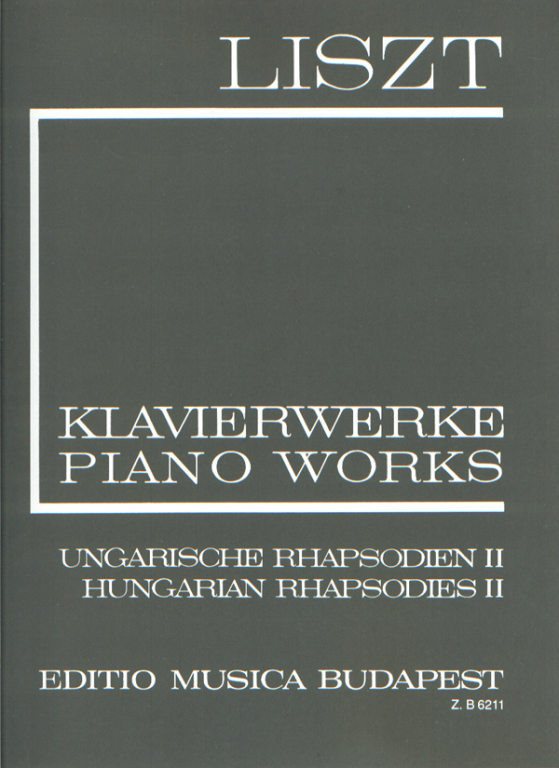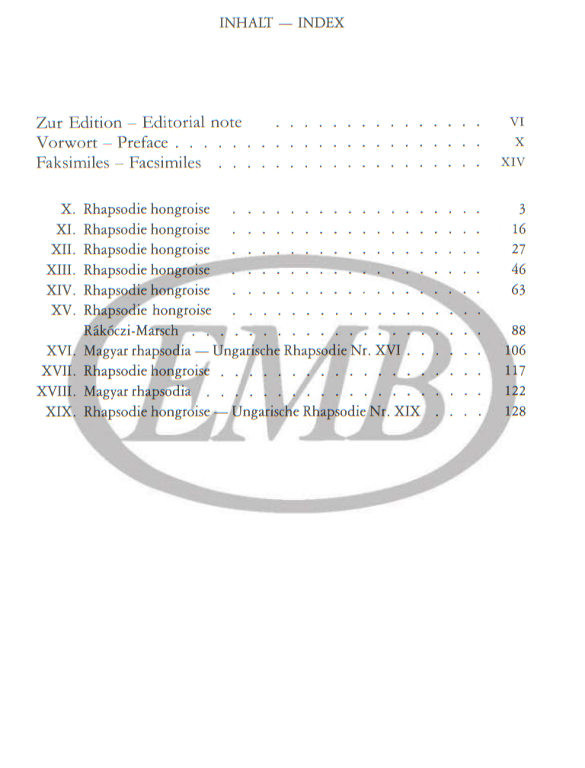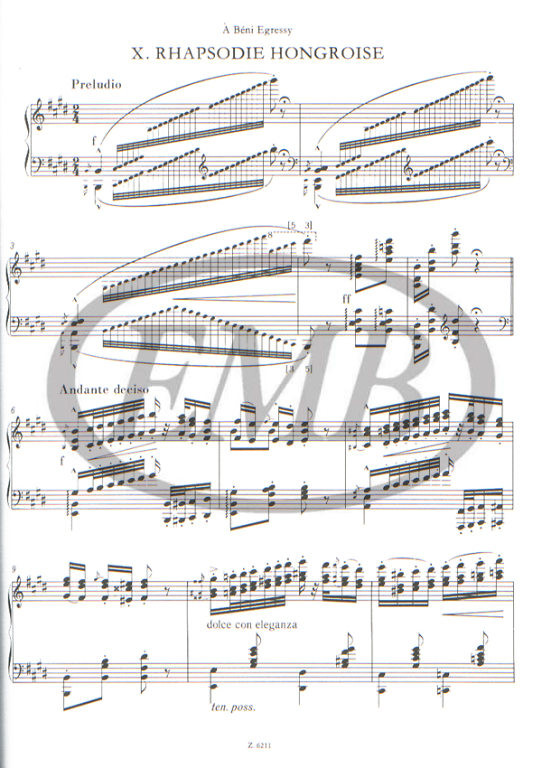Description
Liszt Ferenc: Hungarian Rhapsodies II. (I/4) / Edited by Szelényi István, Gárdonyi Zoltán / Editio Musica Budapest Zeneműkiadó / 1973 / Közreadta Szelényi István, Gárdonyi Zoltán
Paperback
Made in Hungary
Setting: Piano
Series: New Liszt Edition I. 'B'
Genre: Complete Edition
Period: Romantic
Language: English, German
Length: 172 pages
Format: 23 x 30 cm
Weight: 0.202 kg
Published: April 1973
Publisher: Editio Musica Budapest Zeneműkiadó
Item number: 6211
ISMN: 9790080062111 / 979-0080062111
Hangszer/letét: Zongora
Sorozat: Liszt Ferenc összes műveinek új kiadása I. (karton) 'B'
Műfaj: Összkiadás
Korszak: Romantikus
Nyelv: angol, német
Terjedelem: 172 oldal
Formátum: 23 x 30 cm
Súly: 0,202 kg
Első megjelenés: 1973. április
Kiadó: Editio Musica Budapest Zeneműkiadó
Katalógusszám: 6211
Liszt was greatly influenced by the playing of the Gypsy orchestras that he heard in 1840 and 1846, when he spent a few weeks in Hungary. The music they played was mainly verbunkos (recruiting music) and czardas, Hungarian popular artsongs, and sometimes even folk songs. Liszt studied the performance style of the Gypsy musicians with the rigour of a folklorist, and in his sketchbooks he transcribed the songs that he heard with their special stylistic traits. His concerts too featured works pieced together from Hungarian melodies, which later served as proto-studies for the later Hungarian Rhapsodies.
The first 15 rhapsodies appeared in print in 1851-53, with numbers 16-19 written three decades later. Rhapsodies 1-15 and 19 can be traced back to foreign themes, while in nos. 16-18 Liszt used his own thematic ideas. By the 1880s Liszt's musical idiom had changed greatly: by then he was using a simpler, denser piano sound, but all the rhapsodies adhered to the 'lassú-friss' (slow-fast) structure.
As customary, there are two versions of the publication: a blue clothbound edition and a grey softcover edition. The preface, which gives the most important information on the contents and technical details, is identical in both versions, but only the former includes an English description of the sources and a critical commentary. Both versions include facsimiles of pages from Liszt's original autograph manuscript.
Lisztre nagy hatással volt a cigányzenekarok játéka, akiket 1840-ben és 1846-ban hallott, amikor Magyarországon töltött néhány hetet. Főként verbunkos- és csárdászenét, magyar népies műdalokat, nagy ritkán népdalokat játszottak. Liszt szinte egy folklorista alaposságával tanulmányozta a cigány muzsikusok játékmódját, s vázlatkönyveiben feljegyezte a hallott dalokat és azok stílusbeli sajátságait. Koncertjein is megjelentek a magyar dallamokból építkező művek, melyek a későbbi Magyar rapszódiákhoz szolgáltak előtanulmányként.
1851-53 között jelent meg nyomtatásban a rapszódiák első 15 száma, a 16-19. darabok három évtizeddel később születtek. Az 1-15. és 19. rapszódiák idegen témákra vezethetők vissza, a 16-18. számokban Liszt saját tematikus ötleteit használja fel. Liszt zenei nyelvezete sokat változott a 80-as évekre; ekkor már egy jóval letisztultabb, tömörebb zongorahangzást valósít meg, de a lassú-friss felépítés mindegyik rapszódiában megmaradt.
A kiadvány két változata az eddigiek szerint kék vászonkötésben és szürke kartonkötésben jelent meg. A művekről a legfontosabb tartalmi és technikai tudnivalókat ismertető előszó mindkét változatban azonos, míg a forrásleírásokat és a kritikai megjegyzéseket csak az előbbi változat tartalmazza. A kötet elején mindkét változatban Liszt eredeti kéziratlapjainak hasonmásai láthatók.
Contents / Tartalomjegyzék
|
1. |
X. Rhapsodie hongroise R. 106, SW 244, NG2 A132 |
|
|
2. |
XI. Rhapsodie hongroise R. 106, SW 244, NG2 A132 |
|
|
3. |
XII. Rhapsodie hongroise R. 106, SW 244, NG2 A132 |
|
|
4. |
XIII. Rhapsodie hongroise R. 106, SW 244, NG2 A132 |
|
|
5. |
XIV. Rhapsodie hongroise R. 106, SW 244, NG2 A132 |
|
|
6. |
XV. Rhapsodie hongroise Rákóczi-Marsch R. 106, SW 244, NG2 A132 |
|
|
7. |
XVI. Magyar rhapsodia - Ungarische Rhapsodie Nr. XVI R. 106, SW 244, NG2 A132 |
|
|
8. |
XVII. Rhapsodie hongroise R. 106, SW 244, NG2 A132 |
|
|
9. |
XVIII. Magyar rhapsodia R. 106, SW 244, NG2 A132 |
|
|
10. |
XIX. Rhapsodie hongroise - Ungarische Rhapsodie Nr. XIX R. 106, SW 244, NG2 A132 |

























